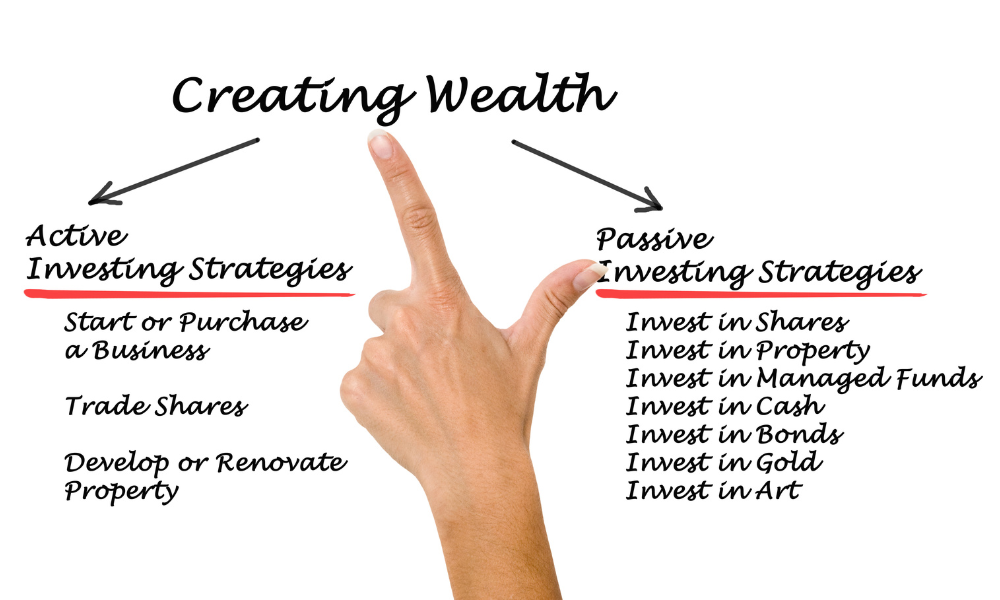Explore different ways to build sustainable passive income streams through tax-smart, diversified strategies tailored for varying financial goals

- What is passive income?
- How important is the role of passive income in wealth planning?
- Top smart passive income ideas for Canadian investors
- Factors to consider when choosing the right passive income strategies
- What are the most effective ways to generate passive income?
- How to find the right passive income strategy
Passive income can be a great way to earn big bucks for doing almost no work. But the term is often misunderstood. Anyone looking to open this type of income stream should know up front that it doesn’t literally mean doing no work.
Especially in the beginning, you’ll likely need to invest not only money but also time and commitment. By doing so, you get the opportunity to earn a lot of money in the long run.
In this article, Wealth Professional explores the top smart passive income ideas for investors wanting to boost their portfolio. We also talked to industry experts who shared insights into the role passive income plays in wealth creation.
What is passive income?
Passive income, sometimes called unearned income, is income that requires little work to make and maintain and usually comes from sources outside of a traditional employer. As the name implies, earning passive income doesn’t always require your active participation.
Unlike active income, passive income is generated automatically and creates residual income with considerably less effort and time. Not only does it have the potential to make you more money, but it also frees up your time. This can ultimately help you to reduce any workplace stresses in your life.
How important is the role of passive income in wealth planning?
“Passive income plays a vital role in both the creation and preservation of wealth,” says Mustafa Bukhari, national team lead at Guelph-based Skyline Wealth Management Inc. “It provides a steady, recurring stream of income that can be reinvested to harness the power of compounded growth.
“Beyond growing wealth, passive income offers financial flexibility by helping to cover everyday expenses, providing a buffer during periods of economic uncertainty when volatility persists, or support more complex strategies such as leveraging borrowed capital for investment purposes.”
Bukhari, who is among Canada’s Best Financial Advisors and Professionals Under 40, adds that investors can benefit from deferred taxation of certain passive income sources to boost overall portfolio returns. These sources include dividends, capital gains, and return of capital.

Susyn Wagner, senior wealth advisor and senior portfolio manager at Wellington-Altus Private Wealth Inc., highlights the importance of passive income in retirement planning.
“It's important to have multiple sources of income because they add a layer of security, protecting your plan from market shifts and unexpected expenses,” she explains. “While some Canadians rely on government pensions, employer pensions, or annuities, these sources aren’t always available to everyone.
“By using self-directed registered accounts like RRSPs, TFSAs, or non-registered portfolios, you can create your own passive income streams. Adding dividend-paying stocks, REITs, or interest-bearing vehicles to these accounts, combined with a solid cash reserve, gives you a diversified income strategy that supports long-term stability.”
Get to know more about Wagner and other prominent women in the industry in our special report on the Top Female Financial Advisors and Professionals in Canada.
Top smart passive income ideas for Canadian investors
Investing is one of the most popular ways to generate passive income. With the right investments, you can earn a consistent stream of cash flow without doing much of the heavy lifting. Below, we list some of the top investment-based passive income examples that can bolster or complement your existing portfolio.
1. Dividend-paying stocks
If you own shares in a company, you may be able to earn a steady income stream through cash dividends. Companies pay dividends to shareholders on a regular basis, often quarterly, from the profits they earn.
To get big dividend cheques, you will have to invest a significant amount of money and spend the time conducting research on good stocks. The key is finding well-established companies with a long history of paying shareholders dividends. A good example is bank stocks.
If you want to learn more, you can check out our guides below on how to invest in stocks from Canada’s biggest banks, complete with prices and analysis:
Dividend payments, however, aren’t always guaranteed. If the business is struggling or the economy is weak, a company may choose to cut or suspend payments.
2. Bonds and bond funds
Bonds and bond funds are considered a safer investment compared to stocks, but the returns are often lower. These investment vehicles allow you to lend money to companies and federal, provincial, and municipal governments. You generate passive income through regular interest payments and the principal amount at the time of maturity.
Bonds and bond funds are a great way to diversify your portfolio. You can buy bonds directly from financial institutions or through brokerages. Most bonds and bond funds have a minimum purchase amount. Interest payments are deposited monthly in your brokerage account or any other personal account you designate.
3. Dividend ETFs and index funds
Dividend exchange-traded funds and index funds consist of shares from several dividend-paying companies. Compared to stocks, these investment vehicles offer exposure to more companies. This built-in diversification provides protection against losses.
ETFs and index funds are managed by professional managers, who pick the funds on your behalf. This hands-off approach makes these types of investments among the most passive income sources for investors. ETFs and index funds pay out regular dividends just like stocks.
Find out the similarities and differences between ETFs and mutual funds in this guide.
4. Money market funds
Money market funds are mutual funds, although a few are ETFs, that make short-term investments in highly liquid and low-risk debt securities. These include cash equivalents, treasury bills, and bonds.
If you’re an investor who prefers to earn fixed interest while protecting capital, you may find this passive investment strategy appealing. Money market funds are popular in high-interest environments as they give you a steady income stream with less volatility than stocks. The funds can also be easily exchanged for cash, usually with a few days’ notice.
5. Investment properties
If you want to get exposure to the real estate market while earning passive income, then buying an investment property is a good option. Investment properties are designed for the sole purpose of making a profit.
You can earn money through rental income, if you prefer a long-term approach, or resale of the property, if you’re into short-term investments. You can have both if you own multiple investment properties.
Depending on your investment goals, you can choose between residential and commercial investment properties.

Managing investment properties, however, requires a lot of time and effort, especially if you prefer handling the property management tasks yourself. It’s also best to set aside an emergency fund to cover maintenance expenses, periods of vacancies, and marketing costs.
Learn more about how to invest in real estate in this guide.
6. Real estate investment trusts
If you don’t have the time or patience to deal with property maintenance and bad tenants, investing in real estate investment trusts (REITs) can be a good alternative. REITs work like mutual funds, but instead of trading stocks, you trade shares of real estate properties.
REITs are a smart passive income idea if you want exposure to the real estate market but don’t have enough funds to buy an investment property. Just like mutual funds, REITs provide built-in diversification. REIT shares sell at a relatively low price. You can also sell them quickly if needed.
If you’re wondering where to invest, this list of the 10 best-performing Canadian REITs can give you options.
7. Mortgage insurance corporations (MICs)
MICs, sometimes called mortgage investment funds, work like mutual funds, pooling money from investors. But instead of using the funds to buy stocks or bonds, MICs pool mortgages. MICs offer loans to mortgage brokers, which then loan the money to real estate developers or aspiring homeowners.
By investing in an MIC, you become a shareholder. As borrowers make interest payments on the mortgage, you receive interest income in the form of dividends.
Check out this guide if you want to learn more about the benefits of joining MICs.
8. Guaranteed investment certificates (GICs)
GICs are among the most popular low-risk investments and passive income strategies in Canada.
GICs work by guaranteeing your investment while allowing the money to earn interest at a variable or fixed rate. Once the GIC matures, you can get the original amount back plus interest earned. GICs are covered by the Canada Deposit Insurance Corporation (CDIC).
Term lengths vary from 30 days to 10 years. Some GICs allow you to withdraw funds without penalties. Others prohibit withdrawals for the entire term. You can learn more about how GICs work in this guide.
9. High-yield savings accounts
Many Canadian banks offer high-yield savings accounts. These accounts have interest rates higher than traditional savings accounts. High-interest accounts are considered among the safest passive income sources. The value of your money, however, is influenced by the movement of interest rates. High-yield savings accounts are insured by the CIDC for up to $100,000 per account.
This guide lists the pros and cons of high-yield savings accounts.
Factors to consider when choosing the right passive income strategies
Bukhari lists several factors that investors should consider when selecting a passive income strategy.
“Investors should start by clearly defining their goals, time horizon, and risk tolerance,” he says. “From there, it’s important to consider the tax treatment of each investment. Does it produce interest income, dividends, capital gains, or return of capital?”
Asset location is another important factor to consider, Bukhari adds. This means that investors need to determine which account types to hold the investments in.
“Interest-bearing products may be better suited for registered accounts like RRSPs, while capital gains could benefit from tax-free growth in a TFSA. Products that distribute return of capital may be best held in non-registered or corporate investment accounts for optimal tax efficiency.”
Wagner, meanwhile, emphasizes the importance of factoring in today’s rates when it comes to generating passive income.
“Ideally, you don’t want to lock in everything at current rates, since that can limit your ability to take advantage of future rate increases,” she explains. “That’s where a laddered strategy comes in. It helps you stagger maturities and reinvestment opportunities over time, so you’re not stuck with the same rate.
“Different investments, like rental properties, can offer higher returns, but they also require more time and come with less liquidity. Balancing these different factors, along with considering fees, taxes, and the potential risks, ensures your portfolio stays flexible.”
What are the most effective ways to generate passive income?
According to Wagner, setting up a diversified strategy that works for your long-term financial goals is the most effective way to earn passive income.
“Focus on investments like dividend-paying stocks, ETFs, and REITs, which help create consistent income streams,” she says. “For clients looking for additional yield, covered call writing funds can be a great option to generate premium income over existing assets. If you're open to more active investments, rental properties and other ventures can also contribute to your income plan.”
Bukhari lists private and public REITs, dividend-paying stocks and ETFs, bonds/GICs, and mortgage investment corporations as effective sources of passive income.
“Outside of traditional investment products, investors can also earn passive income through direct property ownership, such as rental income and business ownership (i.e. royalties and licensing fees),” he adds.
According to both experts, investors can use a combination of passive income strategies that matches their preferences, risk tolerance, and investment time horizon.
How to find the right passive income strategy
Finding ideal ways to earn passive income involves several steps. Here are some key pieces of advice from Wagner:
- Clarify your long-term goals and assess your risk tolerance.
- Once you have a clear picture of what you want, think about whether you need liquidity or can handle less liquid assets like real estate.
- Diversify your investments; don’t rely on just one strategy. Consider a mix of dividend stocks, covered call funds, and possibly rental properties.
- Make sure to factor in fees, taxes, and the management involved.
- Always keep a cash reserve to avoid having to sell at an inopportune time.
Bukhari also stresses the importance of seeking guidance from a qualified professional.
“It’s essential to work with someone who has a deep understanding of passive income strategies and who can offer tailored, holistic advice,” he says. “Look for professionals who can clearly explain complex concepts in layman’s terms.
“[They should also] be able to integrate asset allocation and asset location strategies and ultimately provide recommendations that align with your financial goals and personal circumstances.”
A thoughtful, well-structured passive income plan can be a game-changer for long-term financial health. If you’re searching for industry professionals to guide you, our Best in Wealth Special Reports page is the place to go.
Our special reports feature only companies and individuals recognized as respected and reliable market leaders. By partnering with these industry experts, you can rest assured that you’re getting the right guidance in every step of your investment journey.
Did you find our list of investment-based passive income ideas helpful? Let us know in the comments



